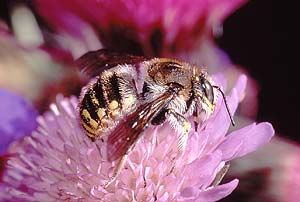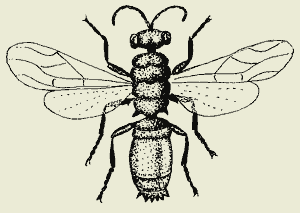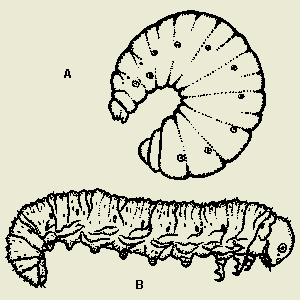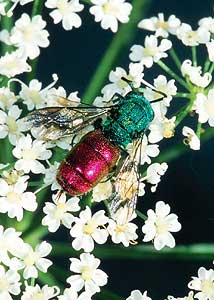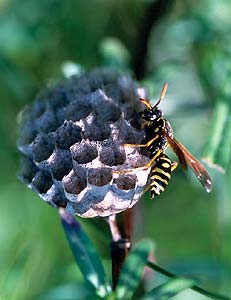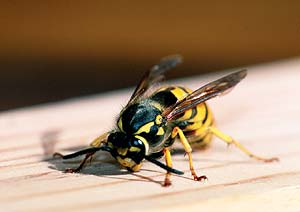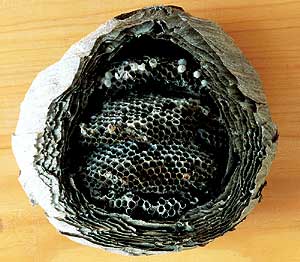|
TERRESTRIAL INSECTS
|
|||||||||||||||
Text:
|
Hymenopterans
Worldwide there are ca 110 000 insects belonging to Hymenoptera order, of which some 9 000 have been found in Poland. In the Wigry National Park more than 300 Hymenoptera species have been found. The best studied Hymenoptera species include wild bees, ants, digger-wasps and gold wasps.
Hymenoptera have web-like, transparent wings. The hindwings are connected with the forewings via numerous hooklets which act during the flight as a single planar surface. They have mouth of chewing or sucking type, with well developed upper jaw. Apart from the typical three segments, their thorax includes the first segment of the abdomen. The female abdomen ends with an ovipositor or sting. In Hymenoptera there is complete metamorphosis: the larvae are legless (maggots) caterpillar-like, with abdominal or thoracic legs. The size of Hymenoptera varies between 2.5 mm (trichogramma wasp) and 40 mm (giant wood wasp).
Hymenoptera are an insect group widely diversified in terms of their biology. They include phytohagous hymenopterans, predators (wasps, digger-wasps) and parasites (terebrant thrips). Hymenopterans feed on plant material, e.g. the wood of standing trees Siricidae or tree leaves (web-spinning sawfliesPamphilidae and sawflies Tenthredinidae), terebrant thrips are parasitic on insects and arachnida (e.g. true ichneumon flies ( Ichneumonidae), bracon flies (Braconidae) and chalcid wasps (Chalcididae), and aculeates may feed on animal material (e.g. social wasps Vespidae), plants (e.g. bees Apoidea) or they can be omnivorous (e.g. some ant species from Formicidae). In some Hymenoptera the larvae are predators, while adults feed on pollen, nectar and plant juices.
Hymenoptera are divided into insects in which the abdomen connects with the thorax without differentiation (phytohagous hymenopterans) and insects in which there is a distinct waist between the thorax and abdomen (Petiolata).
Females in some aculeates have a sting, being a transformed ovipositor (which primarily served for laying eggs). The sting is used for defence and attack – the toxin flows from the sac, through a channel inside the sting, to the body of the sting animal. The bitten often ends with hooklets and burrs which make removal of the sting from the body of the attacked animal difficult. A female from the scolid wasp family (Scoliidae) paralyses beetle larvae and then lays eggs in their bodies. The scolid wasp larva feeds on tissues of the beetle larva. Sapygid wasps (Sapygidae), in turn, parasitize wild bees, while velvet ants (Mutilidae) parasitized bees and Sphecidae. Spider-hunting wasps (Psammocharidae) lay eggs mainly on paralysed spiders which are buried in deep burrows.
Gold wasps (Chrysididae) are a very specific group of aculeate hymenopterans – being parasitic on other aculeates. Their bodies are covered with a strong scutum having beautiful, metallic colours: pink, green, violet, and blue. The females of common gold wasps lay eggs in the nests of wild bees, digger-wasps and wasps. Digger-wasps dig dens where they bring captured insects, insect larvae and spiders. Digger-wasps are paralysed by a sting bite, while smaller ones such as aphids are pressed with the mandibles in the head area.
Some Hymenoptera live a social life: adults take care of the offspring, the family roles are divided and offspring help their parents. Such a phenomenon can be observed in some wasps, bees and ants. For example, the largest Polish wasp – hornet (Vespa crabro) – leads such life. In late spring a female hornet, which wintered in shelter, establishes a nest and takes care of her first worker larvae. After hatching the workers take over most of her duties related to the construction of the nest and caring offspring from the female. In the second half of summer, males and females hatch from a part of the eggs, and the nest made of wooden pulp has quite often a diameter exceeding 0.5 metre.
|
||||||||||||||
|
|
|
